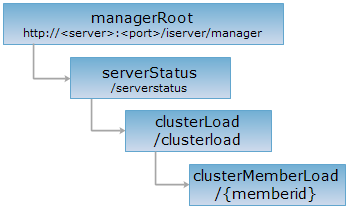
<clusterLoad uri>/{memberid}[.<format>]
clusterMemberLoad is the child node resource in the cluster system. Through this resource, you can view the current concurrency traffic and average traffic of each child node.
Supported Methods:
Supported output formats: rjson, json, html, xml.

Implement the HTTP request on the following URI, where supermapiserver is the server name, with rjson being the output format.
http://supermapiserver:8090/iserver/manager/serverstatus/clusterload/{memberid}.rjson
Gets the detailed info of child note specified by memberId, including the current concurrency traffic and average traffic.
Implement the GET request on the clusterMemberLoad. The URL can contain the following parameyters:
| Name | Type | Description |
| componentName | String | Service component name. This parameter can be used independently. |
| interfaceName | String | Service interface name. This parameter can not be used independently. It must be used with componentName. |
Execute the GET request to clusterMemberLoad. Return the detailed info of the each child node, as follows:
| Field | Type | Description |
| averageTime | int | The average response time of the server. The unit is second. |
| currentCount | int | The current concurrency. |
| historicalAccessCounts | int[] | Record the concurrency of server in 5 minutes. |
| interval | int | The time interval of service accessing statistics. Default is 1 second. |
| ip | String | The server IP. |
| memberId | String | The Id corresponding to child node. |
| port | int | The port number of the server. |
Implement the GET request on the clusterMemberLoad resource http://localhost:8090/iserver/manager/serverstatus/clusterload/f4a5f3f05619478caad7c8b51000827d.rjson. Return rjson results:
{
"averageTime": 0,
"currentCount": 0,
"historicalAccessCounts": null,
"interval": 1,
"ip": "192.168.17.182",
"memberId": "f4a5f3f05619478caad7c8b51000827d",
"port": 8090
}
Asks for the response identical to the one that would correspond to a GET request, but without the response body. This is useful for retrieving meta-information written in response headers, without having to transport the entire content. The meta-information includes the media-type, content-encoding, transfer-encoding, content-length, etc.
HEAD request can be used to check if the clusterMemberLoad resource exists, or if the clusterMemberLoad resource can be accessed by clients. It can also determine if the clusterMemberLoad resource supports an output format <format> if performed on a URI with .<format> included.